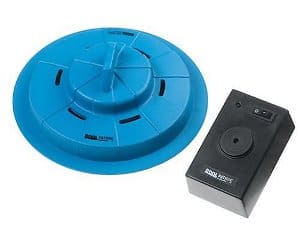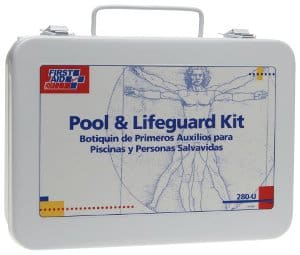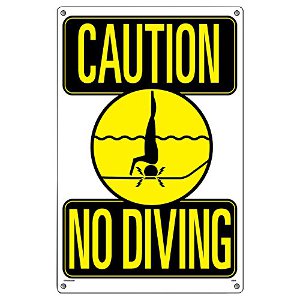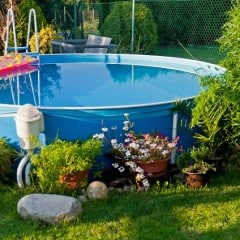Disclosure: This article contains affiliate links. The owner of agpoolreviews.com receives a commission when you click one of these links and purchase a product.
You often hear that above ground pools are safer than inground pools – and in many ways, it’s true. But don’t let that lull you into a false sense of security. Look closely at pool safety statistics, and you’ll see that many – too many – serious accidents happen at above ground pools every year.
The best way to prevent a tragedy from happening at your pool to make sure there’s a responsible adult watching over it whenever it’s in use. When the pool is not in use, it should be secured to make sure unsupervised children can’t access it.
How exactly do you keep a backyard pool secure? There are lots of different ways, some of which may be mandated by the laws in your area. Here’s a quick overview of some of the most important aspects of above ground pool safety.
Fences
No doubt, fences deserve first mention due to their effectiveness and the fact that they’re often included in pool safety laws. Note that a safety fence should ideally have a self-closing, self-latching, and lockable gate. If it’s a perimeter fence that connects to your home, you should consider additional barriers or safety measures to protect young ones who might wander out your back door. For a lot more information, check out this article on safety fences.
Ladders
One of the reasons above ground pools are considered safer is because the pool walls serve as a barrier to entry. However, that’s only true if the pool ladder is secure. When no one’s using the pool, the ladder should be removed or locked to prevent kids – or pets, for that matter – from climbing in.
Safety Equipment
When it comes to pool safety products, there’s no shortage of options. However, many of them come with drawbacks and are not in any way a substitute for a safety fence. Still, in addition to a barrier, these options can make your pool even safer.
Covers
To avoid confusion, note that we’re talking about safety covers here. Other types of above ground pool covers – including solar covers – are not designed to hold the weight of a child. While they’re undeniably effective, the main issue with safety covers is that they require you to be conscientious about using them.
Alarms
Door and gate alarms can alert you when someone enters your backyard. You can also find water disturbance alarms that tell you when someone (or something) is in the water unsupervised.

This alarm detects waves on the surface of your pool, alerting you when an unsupervised child or pet enters the water. While some water disturbance alarms are solely for inground pools, this one works for above ground pools as well.
Life Vests
Most above ground pools aren’t that deep, but if little ones can get in over their head, it’s a good idea to have life vests and other flotation devices around. Just don’t become overly reliant on them – swimming skills and adult supervision are still necessary.
First Aid Kits
While drowning is a definite risk in above ground pools, other types of injuries are probably more common. That’s why a first aid kit is a must for any pool area. Put it in a place that’s easy to reach, and make sure everyone in your household knows about it.

This first aid kit is designed specifically for use around the pool. It has remedies for everything from bug bites to serious mishaps.
Scamper Ramps
If you have a dog that loves the water, you may want to look into a scamper ramp. These ramps allow dogs and other animals to crawl out of the pool in case they somehow wind up in the water when you’re not around. While they’re more common in inground pools, you can also find ones that work with above ground pools.
Behavior
All the safety equipment in the world won’t help if the people who use your pool engage in risky behavior. Unfortunately, when you’re having fun, the part of your brain that says “don’t do that” tends to shut off. Here are some tips on keep you and your family safe when using the pool:
1. Post pool rules
Your pool probably came with a sign or stickers saying “No diving!” Make sure that message is in a prominent place, along with other safety rules. Most importantly, make sure any kids using your pool read the rules before getting in the water.

Above ground swimming pools aren’t deep enough for diving, and everyone who uses your pool should be aware of that fact. A bold sign like this can help get the message across.
2. Keep the pool area uncluttered
If you leave toys or other things in the water, that’s an invitation for kids to climb in. If you leave things outside the pool, it gives them something to climb on to get over the pool wall. Bottom line, it pays to be slightly anal when it comes to tidying up around the pool.
3. Watch your alcohol use
A lot of swimming pool accidents happen when people are drinking and doing dumb stuff they wouldn’t ordinarily do. If you’re going to drink, be on guard against the loss of impulse control that follows. And never trust a drunk person to supervise kids.
4. Teach children to swim
Knowing how to swim can save a person’s life – if not in your pool, then in some other situation down the road. It’s a good skill for every child to have, but especially ones who have a pool in their backyard.
5. Supervise!
We had to throw this one in one more time because it’s so important. No matter how much you preach safety to your kids, there’s going to be a time when they try something that isn’t safe. The only question is whether you or another responsible adult is there to stop them.
While this article is a great place to start learning about above ground pool safety, there’s lots more information available online. If you want to go the extra mile, we recommend this Red Cross checklist for pool maintenance and safety. In any case, good luck and stay safe!



